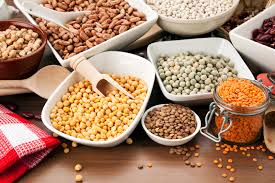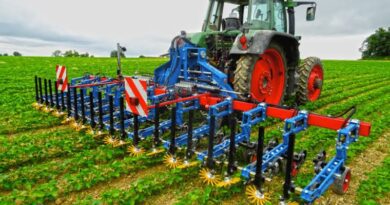Classification of Feeding Stuff and Feed Supplements: Legumes
Legumes are plant species of the family Leguminosae. They have seed pods that, when ripe, split along both sides. Legumes are a significant source of protein, dietary fiber, carbohydrates and dietary minerals; manganese. Like other plant- based foods, contains no cholesterol and little fat or sodium.
Legumes are also an excellent source of resistant starch which is broken down by bacteria in the large intestine to produce short-chain fatty acids (such as butyrate) used by intestinal cells for food energy.
The legume family is probably the third largest of the vascular plants. Orchid and grass families are larger. However, economically, legumes are second only to grasses in importance because of their extensive use as forages.
While only about 40 legumes are significant in forage production, there are 12,000-18,000 species. Forage legumes, such as alfalfa, clovers, and trefoils are generally of high quality, and their digestibility declines less rapidly as the plant matures than that of many perennial grasses.
Legumes have a longer window for best utilization, so they fit well into a feed calendar. Legumes also generally have higher levels of protein than grasses. But legumes require more management than grasses because they are more sensitive to fertility and edaphic (soil) factors.
Legumes and grasses can be mixed together to take advantage of their strengths but since they have different characteristics mixtures must be more carefully managed Forage managers must learn to utilize grasses and legumes for maximum quality and yield.
The banning of meat and bone meal in animal diets has led to increased interest in vegetable protein sources.
Soybean meal is the predominant protein source for animal diets worldwide, but the increased use of genetically-modified (GMO) soybeans has resulted in an interest in alternative sources of vegetable protein, especially among organic poultry producers.
Some other legumes can be used as alternative feed ingredients.
Legumes are noted for their ability to use nitrogen from the air. This ability is the result of a symbiotic relationship between the plants and bacteria (rhizobia) found in root nodules.
This ability to use atmospheric nitrogen reduces fertilization costs and allows legumes to be used in crop rotation to replenish soil that has been depleted of nitrogen. Legumes break the annual cycle of cereals, reducing the buildup of cereal weeds and pests.
Types of Legumes
Grain legumes refer to those crops cultivated for immature or mature grain.
Forage legumes refer to legumes consumed as forage. Forage legumes can also be used as a source of biomass and green manure.
Nutritional Quality of Legumes
Legumes have been mostly used as feeds for ruminants, although there are some reports of their inclusion in the diets of non-ruminants (pigs and poultry). The leaves, stems and fruits may be used either as a complete feed or as a supplement to other feeds.
Legume seeds have twice as much protein as grains. Crude protein content of legume grains ranges from 27% in peas and faba beans to almost 50% in soybeans.
The proteins are digested in the rumen to provide ammonia and amino acids for microbial cells in protein synthesis. Legume grains are also high in iron and B vitamins.
Limitations
One of the factors limiting the use of grain legumes as feed is the presence of antinutritional factors in legumes that decrease the nutritive value of the grain and, if consumed in large amounts, cause health problems for animals.
These anti-nutritional factors include protease inhibitors, lectins, oligosaccharides, phytate, antivitamins, L-canavanine, tannins, and isoflavones.
Antinutritional factors and species where they are found
| Anti-nutritional substances | Species | |
| 1. | Non-protein Amino acids | |
| Mimosine | Leucaenaleucocephala | |
| Indospecine | Indigoferaspicta | |
| 2. | Glycosides | |
| (A) Cyanogens | Acaciagiraffae A.cunninghamii A. sieberianaBambusa bambosBarteriafistulosa Manihotesculenta | |
| (B) Saponins | Albiziastipulata Bassia latifoliaSesbaniasesban | |
| 3. | Phytohemagglutinins | |
| Bauhiniapurpurea | ||
| Ricin | Ricinuscommunis | |
| Robin | Robiniapseudoacacia | |
| 4. | Polyphenolic compounds | |
| (A) Tannins | All vascular plants | |
| (B) Lignins | All vascular plants | |
| 5. | Alkaloids | |
| N-methyl-B-phen | ||
| Ethylamine | Acaciaberlandieri | |
| Sesbanine | Sesbaniavesicaria | |
| S.drummondii | ||
| S.punicea | ||
| 6. | Triterpenes | |
| Azadirachtin | Azadirachtaindica | |
| Limonin | Azadirachtaindica | |
| 7. | Oxalate | Acaciaaneura |
Examples of some legumes include;
1. Soybeans
Globally, soybeans (Glycine max) are the most important feed grain legume. Soyabean is an oilseed containing about 20 percent oil. The extraxtion of oil results in a high protein cake.

One of these products is soyabean meal which is one of the main protein source in animal diets.
Soybean, meal is about 44 percent crude protein, while the concentrate contains about 70% CP. Soyabean leaves and stem can be grazed, ensiled or dried to make hay.
Read Also : The Recommended Feeding Pattern for Rabbit Kits
The foliage is very palatable, has a high nutritive value and highly digestible. Raw soyabeans seeds contains trypsin but leaves and stem does not.
2. ChickPeas
Chickpeas (Cicer arietinum) are one of the world’s most important grain legumes. Like other legumes, chickpeas contain such antinutritional factors as protease and amylase inhibitors, lectins, tannins, and oligosaccharides.
These antinutritional factors interfere with nutrient absorption from the digestive tract. Most of the antinutritional factors in chickpeas can be deactivated by heat treatment.
3. Cowpeas
Cowpeas (Vigna unguiculata), also called black-eyed peas, are an important grain legume in tropical and subtropical regions. Cowpeas are heat- and drought-tolerant crops. Cowpeas have an amino acid profile that is similar to that of soybeans.
Cowpea is a legume that is extensively grown, particularly throughout sub-Saharan Africa. It is a subsistence crop, often intercropped with sorghum, maize and pearl millet.
The peas provide valuable protein, the leaves are used as a nutritious vegetable and the rest of the plant serves for animal feed. The plants are drought tolerant and grow well on relatively poor soils. The peas can be consumed fresh or removed from the pods and dried.
4. FabaBeans
Faba beans (Vicia faba) are grown in several countries, especially in the Mediterranean area. The nutrient content of faba beans makes them look like a suitable substitute for soybean meal, but the presence of antinutritional factors has limited their use in poultry diets.
5. FieldPeas
Field peas (Pisum sativum) are grown in several countries. Field peas have been referred to as “feed peas” in Canada and as “protein peas” in Europe.
The relatively low levels of antinutritional factors in pea grains eliminates the need for heat treatment of field peas prior to inclusion in poultry diets.
6. Lupins
Australia is the dominant world producer of lupins, accounting for around 85% of world production. Lupins are also produced in the United Kingdom and western Canada. The high price of organic feed has been hampering the development of organic poultry production.
This has resulted in an increased interest in lupins, which have the advantage of not requiring roasting prior to feeding.
There are two classifications lupins (Lupinus species): bitter and sweet. Bitter types are high in alkaloids, compounds that have been bred out of the sweet varieties.
7. Lentils
Lentils (Lens culinaris) are grown primarily for human consumption, but lentils that fail to meet food-grade standards are available for use in livestock feeds. Lentils have a relatively high protein content and few digestive inhibitors.
8. Vetch
a. Common Vetch
Common vetch (Vicia sativa) is an annual climbing legume. Common vetch originated in southern Europe but is now grown all over the world. Common vetch has many valuable agronomic characteristics:
It is resistant to drought and adapted well to semiarid regions. It can also grow in poor soils. The presence of cyanoalanine toxins has limited the use of common vetch seed in poultry diets.
b. Other Types of Vetch
Bitter vetch (Vicia ervilia) is an old grain legume that originated in the Mediterranean and is now grown around the world. It has high yields and is resistant to droughts and insects. It is a good source of energy, and its amino acid profile is similar to that of soybeans.
The seeds have been used in animal diets, but the presence of canavanine has limited the use of bitter vetch in poultry diets.
In summary, legumes are important because of their extensive use as forages in ruminant nutrition. Forage legumes, such as alfalfa, clovers, and trefoils high quality protein.
Legumes can be used as protein sources and forage. However, the presence of anti-nutrients limits their usage.
Read Also : The Devastating Water Pollution Consequences









